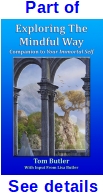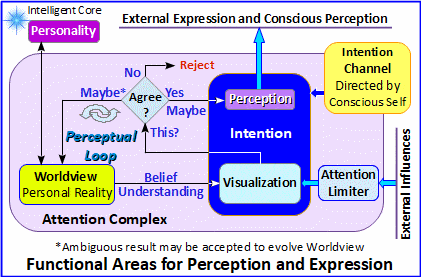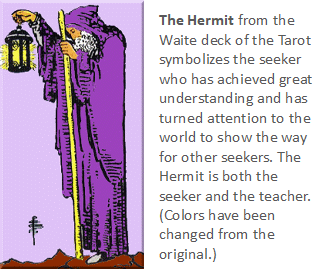 Also, see Ethics as a Personal Code for The Mindful Way.
Also, see Ethics as a Personal Code for The Mindful Way.
I recommend the books:
Your Immortal Self: exploring the mindful way
and Exploring the Mindful Way.
Purpose
The phenomena of transcommunication appear to have a purpose beyond the reassurance it offers to loved ones. After examining mediumistic messages from the other side and “revelations” brought by past teachers, it is easy to imagine that our etheric communicators are trying to teach us about the reality of our immortality by showing us they exist. This article is written as an exploration of the idea that the EVP messages in our recorders, or the paranormal images we find in our photographs, are a new way of telling us that we are part of a larger community. Perhaps it is up to us to understand what that means.
Mindfulness
The terms “mindfulness” and “mindful living” have become catchphrases for right living, but not in a pretentious way or in an attempt to tell you what to do. People speak of mindfulness, almost in a reverent tone, as if the concept relates more to God than to daily living. Always, it is used to offer guidance in how to improve your life; how to be all that you can be.
Discussions about the phenomena of transcommunication are usually about technique and quality of examples. Who is talking may be discussed, especially if the information seems to come from a loved one, but the question of continuous life seldom comes up. In fact, considered from the perspective of your immortality, transcommunication may actually be all about our immortality. If this is true, then learning to habitually be aware of the consequences of our actions and implications of our beliefs may be the most important ability we can learn.
Teachers
The Mindful Way is based on the idea that what we do now matters here and hereafter–both to us and to others with whom we share reality. Information about this has come to us by way of Instrumental TransCommunication (ITC), meditation and mediumship.
With proper controls, ITC can be a rich source of information about the other side. For instance, we have seen that we should expect a life review during our transition. We know our friends on the other side can see us, and we know our communicators sometimes “get together” in an etheric cooperative community. We also know that there are changes in their ability or need to communicate, so that some do not “report in” for years and some seem to “move on” after a while.
Mediumistally acquired information, sometimes referred to as channeled material, must be considered with reservation because we know cultural influences can color messages. Even so, consistency amongst communicators seems to add credibility to some messages. [1]
The fabled Hermes of ancient Egypt continues to be an important teacher of The Mindful Way. The only document credited to Hermes that seems reliable is The Emerald Tablet. [2] In it, he speaks of The One Thing, which represents the expression of Source as the organizing principles involved in The Great Work of the Hermetic Tradition. [3] The Great Work is all about the path followed by seekers to gain understanding. The message is that a person benefits by learning to live in accordance with the true nature of reality.
A review of teachings attributed to Jesus, as found in Aramaic-to-English translations, shows that he taught that our I Am presence exists in the greater reality and that our transition out of this lifetime is toward our I Am presence: “Where that I Am really is, there you already are, and you can be, consciously.” (From Luke 24:38-49) He also taught the unity of humankind; that one person’s actions reflect on all people. [4]
A transcript of Hans Bender’s words as conveyed by the Felix Experimental Group’s medium during a séance can be read on the ATransC website. To paraphrase, Bender explained that we are not alone and that how we view the other side has a lot to do with how we experienced it during our transition. He said that what we are doing here affects the other side and that we can project negativity into the greater reality which can cause problems for others.
Jane Roberts’ Seth material appears to be a reliable source of information about the other side. [1] Three important “instructions” from Seth are:
- People create their own reality
- People exist in more than one aspect of reality at once
- The only wrong act is to violate another person.
The common message from all of these sources is that:
- Who we really are–our I Am Presence–always exists in the greater reality
- We are able to connect with our etheric aspect through “right thinking”
- How we think now affects us and others now and beyond this lifetime
- It is for us to learn to live in accordance with the true nature of reality.
This understanding is not one person or one organization teaching religious doctrine. Think of it as the handbook for “right living” given to us by our friends on the other side; this is mindful living.
What We Do Now Matters
If you look behind the curtain of ITC messages, so to speak, a pattern begins to emerge that tells us much about the person. While the messages apparently are paranormal, it has been noted by many researchers that different practitioners are apt to record rather different kinds of messages from the same situation.
To illustrate, Lisa and another person went into a dark room of a reportedly haunted building and recorded for EVP. Lisa is a pragmatic, levelheaded witness and recorded EVP containing useful information. The other person delighted in being scared and expected scary EVP, and in fact, she recorded scary EVP. In both cases, the messages were clearly paranormal, but their character tended to agree with the practitioner’s worldview.
As it turns out, it appears the person’s expectations are projected onto experiences. This has been noted in what has become known as the Sheep-Goat Effect. In that, people who are more psi sensitive (psychic) tend to have more paranormal experiences. In his book, First Sight, [5] Dr. James Carpenter developed a hypothesis for the evidence currently being presented in parapsychology which holds that people are always informed about the world via their natural psychic sensing. Further, he argues that people are constantly psychokinetically influencing their world. See the Perception and Expression Discourse.
What all of this means is that we also see with our inner senses (first sight) and always have some influence on our world with our intention, which is based on what we think is true.
Worldview
Engineers design models for systems they are trying to understand. One way to develop a model is to figuratively put the subject in a “black box” with the known input and output clearly defined. The trick is then to think of what would have to happen inside of the box in response to the input to produce the output. Not knowing for sure what is inside the box, engineers usually solve the problem by theorizing a model with functional areas inside the box.
The functional areas for a person’s mental activity might be modeled as an input from the world as sensed by the person (bright blue arrow at the top in figure above), an output as the person decides whether or not to act via speech or deed (bright blue arrow at right), an area where memory is stored (worldview), and the processes of visualization, perception and expression.
Researchers have found that people imagine what they are experiencing, and the information for that imagining comes from the worldview database. If the incoming information agrees with the database, then it will actually be experienced by the person. If it does not match the database, then it will either be changed to agree with the database and experienced in that changed form or rejected outright. (Refer to the Functional Areas for Perception and Expression Diagram (below).)
The way we express ourselves involves the same processes. Something causes us to react, and however that initial stimulus is translated by worldview, an imagined reaction is developed. At that point, it is just a fantasy, but if we intend to act, then, what is visualized is expressed in some way. The rest of the story is that, with that intention to act, we begin to psychokinetically influence the world.
Using this model, it becomes evident that worldview plays an important part in our lives. By all indications, we are born with a more-or-less empty worldview database. It appears reasonable to argue that we do begin with a degree of understanding so that one might say that a child is “an old soul” if born with more than average understanding about the world. It seems reasonable to say that the average person’s worldview is full of what has been taught by teachers, parents, clergy and the media. Much of that is simply local custom or popular wisdom.
Personal Reality, Local Reality and the Greater Reality
Of course, there is only one actual reality, but there are differences in the way people experience that one reality. This is all about the individual person, so it is important to understand that each of us has a local reality which is that part of the greater reality which we are aware of, and more importantly, to which we pay attention. Our hometown is part of our local reality, but there are likely parts of it we are actively aware of and other parts that only provide background for the sense of town. Our neighbor will have a slightly different local reality and someone living in another country will hardly be aware of most of what we think of as real.
The greater reality just is. It does not have the capacity to be positive or negative. The same can be said of local reality: it just is. How we perceive our local reality is rather different. For instance, where we live just is, but it has characteristics such as good, bad, warm or uninviting, depending on how we think of it. Our personal reality is how we perceive our local reality; what we think of it. Right or wrong, as far as we are concerned, our personal reality is the real reality and that is determined by our worldview–what we have been taught but biased by whatever understanding we have achieved.
In mindful living, we are taught to examine our worldview to see if what we believe is true makes sense. The idea is to align personal reality with local reality; the true nature of reality and not what we have been taught to think is true.
Suspended Judgment
We have to decide … everything. If not what we experience, then we must at least decide how to react. Self-determination also means that we create our world. Again, not necessarily the brick and mortar places and things we live in, for we live in a collectively visualized venue for learning. For sure, we decide how to react to these things.
Two people might have essentially the same experience, but each will remember it in a different way. A person who is in the habit of thinking things always go wrong will likely remember it as a bad experience; however, a person who is generally optimistic about life is likely to remember it as a good experience or at least as a learning experience. It is all about attitude and that is a learned thing.
Here too, suspended judgment can help. Whatever we think the world is like, we can learn to consciously intercept that “Oh, it’s awful” response with either a “wait and see” or an “it has a good side” response. You may be thinking that this is idealistic, but it works. Once it becomes a habit to intercept those internal decisions, there is more room for alternative explanations for what we experience. An awful reaction tends to stop further consideration of alternative explanations.
We are always psychically interacting with your environment. How we think of incoming information also has a lot to do with how that information continues to develop. It is likely that a positive or at least neutral response will encourage a more beneficial effect in our environment.
Self-Determination
We have to decide … everything. If not what we experience, then we must at least decide how to react. Self-determination also means that we create our world. Again, not necessarily the brick and mortar places and things we live in, but for sure how we react to these things. Two people might have essentially the same experience, but each will remember it in a different way. A person who is in the habit of thinking things always go wrong will likely remember it as a bad experience; however, a person who is generally optimistic about life is likely to have remembered it as a good experience or at least as a learning experience. It is all about attitude and that is a learned thing.
Here too, suspended judgment can help. Whatever you think the world is like, learn to consciously intercept that “Oh, it’s awful” response with either a “wait and see” or an “it has a good side” response. You may be thinking that this is idealistic but it works. Once it becomes a habit to intercept those internal decisions, there is more room for alternative explanations for what you experience. An awful reaction tends to stop further consideration of alternative explanations.
You are always psychically interacting with your environment. How you think of incoming information also has a lot to do with how that information continues to develop. It is likely that a positive or at least neutral response will encourage a more beneficial effect in your environment.
Mindful Living
This is an abbreviated discussion about the Mindful Way. The main message is that what we do now will follow us for the rest of our existence–here and hereafter. The more our personal reality agrees with the actual nature of reality, the more progress we will make in our evolution toward a spiritually mature personality; understanding begets understanding.
The key is to stop and think before we react. To paraphrase Jane Roberts’ Seth, perhaps the only sin is to impose our will on others. We must learn to stop and think about how our actions affect others. We are citizens of our community, the world … and the greater reality. We psychically interact with it so that our feelings about another person in some way affect that person.
The only right we have is to decide what we think of our world and how we will react to what we decide. We are the only judge as to how well we are doing and that is not based on what we have been taught but on understanding we have gathered during our existence.
In an ideal world, people would just naturally be mindful of how they are doing as citizens. Laws to enforce behavior considered common decency today would be unnecessary because people would be mindful of how their actions might affect others. Of course, we do not live in an ideal world, but that is the point. We are also a society of people whose personal reality is very different than the actual nature of reality. The ideal of the Mindful Way is to evolve a society of people who understand they are part of a community.
References
-
Cunningham, Paul F. “The Content-Source Problem in Modern Mediumship Research,” River University, 2012, rivier.edu/faculty/pcunningham/Publications/CunninghamJP_Fall-2012-Vol-76-(2)-295-319.pdf.
-
Butler, Tom, “The Hermes Concepts.” Etheric Studies. 2016. ethericstudies.org/hermes-concepts/.
-
Waite, Arthur Edward, “The Pictorial Key to the Tarot.” 1911. sacred-texts.com/tarot/pkt/index.htm.
-
Grimes, Roberta A., “How Gospel Analysis Can Be Combined with Afterlife Evidence and Traditional Science to Help Us Better Understand Consciousness,” The Academy for Spiritual And Consciousness Studies, Inc. 2013 Proceedings.
-
Carpenter, James C. First Sight: ESP and Parapsychology in Everyday Life. Rowman & Littlefield Publishers. 2012. ISBN-13: 978-1442213906.
![]()

